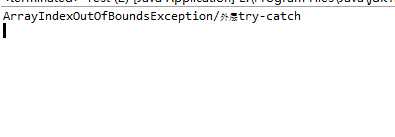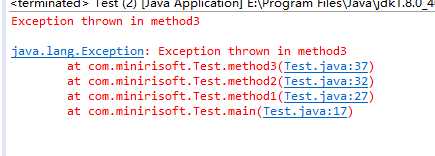标签:异常 方法调用 print end lag 整数 函数 .sh 系统
1.请阅读并运行AboutException.java示例,然后通过后面的几页PPT了解Java中实现异常处理的基础知识。
import javax.swing.*; class AboutException { public static void main(String[] a) { int i=1, j=0, k; k=i/j; try { k = i/j; // Causes division-by-zero exception //throw new Exception("Hello.Exception!"); } catch ( ArithmeticException e) { System.out.println("被0除. "+ e.getMessage()); } catch (Exception e) { if (e instanceof ArithmeticException) System.out.println("被0除"); else { System.out.println(e.getMessage()); } } finally { JOptionPane.showConfirmDialog(null,"OK"); } } }
(1)Java 中所有可捕获的异常都派生自 Exception 类。
基本格式:
Try{
//可能发生运行错误的代码;
}
catch(异常类型 异常对象引用){
//用于处理异常的代码
}
finally{
//用于“善后” 的代码
}
把可能会发生错误的代码放进try语句块中。
当程序检测到出现了一个错误时会抛出一个异常对象。异常处理代码会捕获并处理这个错误。
catch语句块中的代码用于处理错误。
当异常发生时,程序控制流程由try语句块跳转到catch语句块。
不管是否有异常发生,finally语句块中的语句始终保证被执行。
如果没有提供合适的异常处理代码,JVM将会结束掉整个应用程序。
2.阅读以下代码(CatchWho.java),写出程序运行结果:
public class CatchWho { public static void main(String[] args) { try { try { throw new ArrayIndexOutOfBoundsException(); } catch(ArrayIndexOutOfBoundsException e) { System.out.println( "ArrayIndexOutOfBoundsException" + "/内层try-catch"); } throw new ArithmeticException(); } catch(ArithmeticException e) { System.out.println("发生ArithmeticException"); } catch(ArrayIndexOutOfBoundsException e) { System.out.println( "ArrayIndexOutOfBoundsException" + "/外层try-catch"); } } }

写出CatchWho2.java程序运行的结果
public class CatchWho2 { public static void main(String[] args) { try { try { throw new ArrayIndexOutOfBoundsException(); } catch(ArithmeticException e) { System.out.println( "ArrayIndexOutOfBoundsException" + "/内层try-catch"); } throw new ArithmeticException(); } catch(ArithmeticException e) { System.out.println("发生ArithmeticException"); } catch(ArrayIndexOutOfBoundsException e) { System.out.println( "ArrayIndexOutOfBoundsException" + "/外层try-catch"); } } }

当有多个嵌套的try…catch…finally时,要特别注意finally的执行时机。
当有多层嵌套的finally时,异常在不同的层次抛出 ,在不同的位置抛出,可能会导致不同的finally语句块执行顺序。
3.辨析:finally语句块一定会执行吗?
public class SystemExitAndFinally { public static void main(String[] args) { try{ System.out.println("in main"); throw new Exception("Exception is thrown in main"); //System.exit(0); } catch(Exception e) { System.out.println(e.getMessage()); System.exit(0); } finally { System.out.println("in finally"); } } }

4.
当程序中出现异常时,JVM会依据方法调用顺序依次查找有关的错误处理程序。
可使用printStackTrace 和 getMessage方法了解异常发生的情况:
printStackTrace:打印方法调用堆栈。
每个Throwable类的对象都有一个getMessage方法,它返回一个字串,这个字串是在Exception构造函数中传入的,通常让这一字串包含特定异常的相关信息。
// UsingExceptions.java // Demonstrating the getMessage and printStackTrace // methods inherited into all exception classes. public class PrintExceptionStack { public static void main( String args[] ) { try { method1(); } catch ( Exception e ) { System.err.println( e.getMessage() + "\n" ); e.printStackTrace(); } } public static void method1() throws Exception { method2(); } public static void method2() throws Exception { method3(); } public static void method3() throws Exception { throw new Exception( "Exception thrown in method3" ); } }

5.自定义异常通常选择直接派生自Exception:
Class MyException extends Exception
{ … }
在合适的地方使用throw语句抛出自定义异常对象:
Class MyClass {
void someMethod() {
if (条件) throw new MyException();
}
}
在实际开发中,选择正确的异常处理策略非常重要 ,它是系统健壮性的重要保证。
在长期的软件开发实践中,人们己经总结出了多种 切实可行的异常处理方法和策略,在本讲中,我们介绍一种被广泛使用的异常处理方法——通过自定义异常类捕获并处理业务逻辑错误 。
6.
编写一个程序,此程序在运行时要求用户输入一个 整数,代表某门课的考试成绩,程序接着给出“不及格”、“及格”、“中”、“良”、“优”的结论。
要求程序必须具备足够的健壮性,不管用户输入什 么样的内容,都不会崩溃。
package com.minirisoft; import javax.swing.*; class ErrorException extends Exception { ErrorException(String s){ super(s); } } public class Test { public static void main (String[] args){ String str1=JOptionPane.showInputDialog("请输入一个整数"); try{ boolean flag=true; char a[]=new char[100]; for(int i=0;i<str1.length();i++) { if(str1.charAt(i)<‘0‘||str1.charAt(i)>‘9‘){ flag=false; } } if(flag=false) { throw new ErrorException("输入的不是正整数"); } } catch(ErrorException e) { e.printStackTrace(); System.out.print("你输入的数不合法"); } finally { double a=Double.parseDouble(str1); if(a>0&&a<60) { System.out.println("不及格"); } else if(a>=60&&a<70) { System.out.println("及格"); } else if(a>=70&&a<80) { System.out.println("中"); } else if(a>=80&&a<90) { System.out.println("良"); } else if(a>=90&&a<=100) { System.out.println("优"); } else{ System.out.println("你输入的数错误"); } } } }
标签:异常 方法调用 print end lag 整数 函数 .sh 系统
原文地址:http://www.cnblogs.com/youzeshuang/p/6103043.html